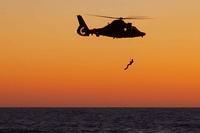If you are preparing for military swimming, diving, treading and general water-confidence tests, make sure you practice with proper technique. That means not just working until you get it right, but also keeping with the program until you can't get it wrong.
Depending upon your abilities, you may need to get in the pool daily and practice techniques. Having someone to coach you is the best way to receive immediate feedback on your technique. Getting someone to film you swimming or treading for one minute can be a decent option to learn how to fix your stroke.
Here are some workouts we like to do in the pool when preparing for a large variety of military and spec ops swimming and diving programs.
1. Warm Up with Your Test Distance
It may take some time to build up to accomplish this, but the sooner you can make the swimming test "just a warmup" physically and mentally, the better off you will be when being tested for the first time.
Most recruit swim tests are 500 meters or 500 yards, depending on the branch of service. Some tests may require swimming with no mask or goggles, in complete cammy uniform or with fins. Make sure you know what the test is and practice every day as a warmup.
2. Ready for the Workout
After you complete the warmup (test distance), mix in some intervals while focusing on conditioning and technique. For an added challenge, make your rest periods between intervals an activity like treading water or events used in the drownproofing test.
We like to do the following:
Repeat 10 times
Swim 50-meter freestyle at a fast pace
Swim 50-meter combat swimmer stroke (CSS) at goal pace
*If you do not need to know the CSS, you can opt for breaststroke or go back to freestyle, but at a sustainable pace (goal pace) after the 50-meter sprint.
*Rest set: On every set or every other set, take a minute to rest by picking an event from the treading or drownproofing sequence (bottom bounce, float, front/back flip, bottom sample -- with hands simulated tied behind the back and feet simulated tied together).
3. Next Step: With Fins
Once you have mastered these types of workouts, you need to get used to swimming with fins. Big SCUBA fins, not slip-on snorkeling flippers, are required in any diving and rescue swimming program. It takes at least a month to get used to swimming with big fins, like the military-issued rocket fins or jet fins.
A good day to work with fins is on your workout's leg days. Finish any leg workout or longer run/ruck with a swim workout with fins. Build up to 1,000 meters and advance to 3,000 to 4,000 meters during your preparation journey. You may find this takes about two to three months to build up, so make sure you plan for that in your training pipeline.
4. Warm Up or Cool Down with Treading or Drownproofing
Once you have mastered your testing distance, consider working on other skills that require more water confidence. Take 10 minutes to warm up on treading, drownproofing events, buddy breathing (with snorkel), or even buddy life-saving (25 meters each).
Work on treading with no hands or even holding a five- to 10-pound weight. All of these events one day will be required throughout any training pipeline for SCUBA, combat swimmer or rescue swimmer training courses. We like to either warm up with this activity or do all the above workout options and do this as a 10-minute cooldown.
The above swimming training options should be done almost every day, depending on your current swimming abilities. If you need a goal pace, shoot for a yard or meter per second. That translates to a 500-yard swim in 500 seconds or 8:20.
If you can keep that pace, that will set you up nicely to being a top performer in the class. Even with fins, if you can keep it at a yard or meter per second, you will be in the top 10%-15% of your class with times of 16-17 minutes per every 1,000 meters. Expanding that pace to 1-2 miles (2,000-4,000 yards) likewise will help you score at the front of the class.
Train to compete, not just survive.
Stew Smith is a former Navy SEAL and fitness author certified as a Strength and Conditioning Specialist (CSCS) with the National Strength and Conditioning Association. Visit his Fitness eBook store if you’re looking to start a workout program to create a healthy lifestyle. Send your fitness questions to stew@stewsmith.com.
Want to Learn More About Military Life?
Whether you're thinking of joining the military, looking for fitness and basic training tips, or keeping up with military life and benefits, Military.com has you covered. Subscribe to Military.com to have military news, updates and resources delivered directly to your inbox.
















